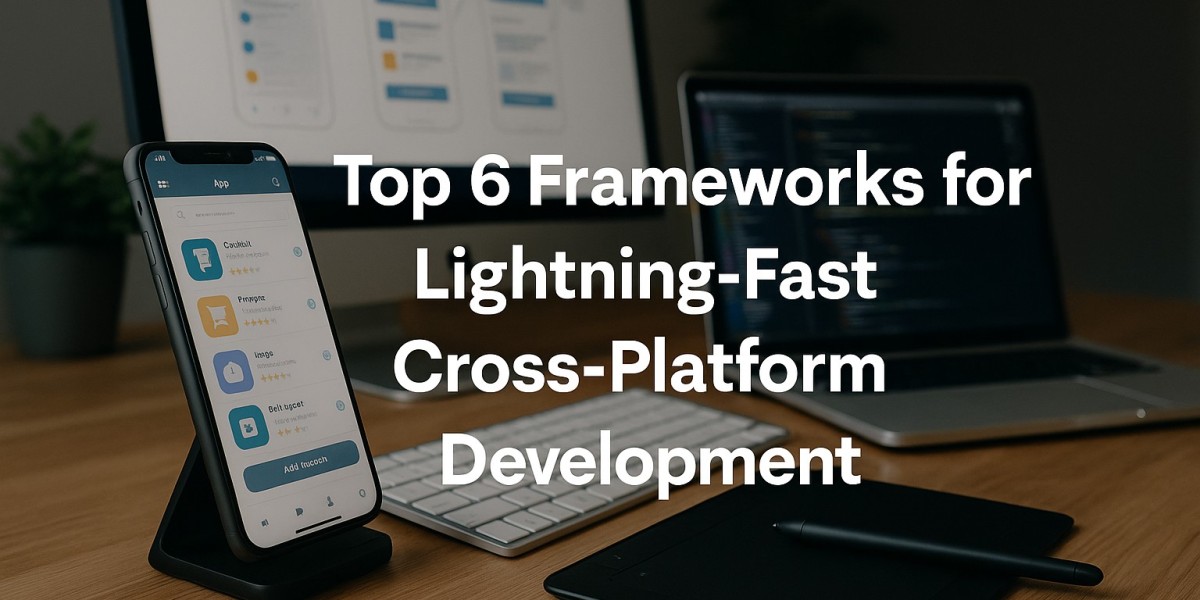In the fiercely competitive mobile landscape, speed is no longer just a desirable trait—it's a fundamental expectation. Users demand applications that load instantly, respond fluidly, and provide a seamless experience, regardless of the underlying operating system. For a Mobile App Development Company aiming to deliver high-quality, efficient, and cost-effective solutions, choosing the right cross-platform framework is paramount. These frameworks allow developers to write code once and deploy it across multiple platforms (primarily iOS and Android), significantly accelerating development while striving for near-native performance.
Here are 6 leading frameworks renowned for building lightning-fast cross-platform mobile apps:
1. Flutter
Developed by Google, Flutter has rapidly ascended to become one of the most popular choices for high-performance cross-platform development. Its design philosophy centers around speed and expressive UIs.
Why it's lightning-fast:
Dart Language & Ahead-of-Time (AOT) Compilation: Flutter uses Dart, which can be compiled directly into native machine code (ARM or Intel). This AOT compilation eliminates the need for an interpreter during runtime, resulting in significantly faster execution speeds and near-native performance.
Skia Graphics Engine: Flutter utilizes its own high-performance rendering engine, Skia, to draw every pixel on the screen. This gives Flutter complete control over the UI, bypassing OEM widgets and ensuring consistent, smooth animations and transitions across all platforms without reliance on platform-specific UI rendering.
Hot Reload & Hot Restart: These features allow developers to see code changes reflected almost instantly in the running application without losing the app's current state. This drastically accelerates the development and debugging cycle, making iteration incredibly fast.
Rich Widget Library: Flutter provides a comprehensive set of highly optimized, customizable widgets that conform to both Material Design (Android) and Cupertino (iOS) guidelines. This allows for rapid UI development without sacrificing performance.
2. React Native
Backed by Facebook (now Meta), React Native is a widely adopted JavaScript framework for building natively rendered mobile applications for iOS and Android. It leverages developers' existing JavaScript knowledge to build mobile experiences.
Why it's lightning-fast:
Native UI Components: Unlike older "hybrid" frameworks that render web views, React Native bridges to actual native UI components. This means the UI elements users see and interact with are the platform's native ones, leading to superior performance and a truly native look and feel.
JavaScript Bridge Optimization: While it uses a JavaScript bridge to communicate with native modules, significant ongoing optimizations have reduced the overhead, making interactions smooth and fast.
Fast Refresh: Similar to Flutter's hot reload, React Native's Fast Refresh feature allows developers to instantly see changes as they code, greatly accelerating the development loop and enhancing productivity.
Large Ecosystem and Community: A massive and active community, along with a vast array of third-party libraries and components, means developers have access to numerous optimized solutions and performance-enhancing tools.
3. .NET MAUI (formerly Xamarin)
.NET Multi-platform App UI (MAUI), the evolution of Xamarin, is Microsoft's open-source framework for building native cross-platform applications with C# and .NET. It's particularly appealing for enterprises already invested in the Microsoft ecosystem.
Why it's lightning-fast:
Native Compilation: .NET MAUI compiles C# code into native binaries for each target platform (iOS, Android, macOS, Windows). This compilation directly to machine code ensures excellent performance, comparable to fully native applications.
Shared Business Logic: Developers can share a significant portion of their codebase, particularly business logic, across all supported platforms. While UI can be customized for each platform, this sharing reduces redundancy and accelerates development.
Performance Optimization Tools: Being part of the .NET ecosystem, MAUI benefits from mature profiling, debugging, and performance optimization tools within Visual Studio.
Hot Reload: Like its counterparts, .NET MAUI supports Hot Reload for XAML (UI markup) and C# code, enabling quick UI iterations and faster development cycles.
4. Kotlin Multiplatform Mobile (KMM)
Developed by JetBrains, Kotlin Multiplatform Mobile (KMM) takes a unique approach to cross-platform development. Instead of a single shared UI layer, it focuses on sharing business logic, networking, and data storage code, while allowing for native UI development on each platform.
Why it's lightning-fast:
True Native UI: Because KMM allows developers to build native UIs using platform-specific UI frameworks (SwiftUI/UIKit for iOS, Jetpack Compose for Android), apps achieve the absolute best native performance and look-and-feel.
Shared Logic, Native Speed: The shared logic written in Kotlin compiles to native code for each platform. This means the core business logic runs at native speeds, while the UI is also fully native, eliminating performance bottlenecks associated with UI abstraction layers.
Incremental Adoption: KMM can be incrementally integrated into existing native apps, allowing companies to gradually adopt cross-platform benefits without a complete rewrite, making the transition faster and less risky.
Concise Language: Kotlin itself is a modern, concise, and safe language that reduces boilerplate code and improves developer productivity, indirectly contributing to faster overall development.
5. NativeScript
NativeScript is an open-source framework for building native mobile apps using JavaScript, TypeScript, Angular, or Vue.js. It distinguishes itself by providing direct access to native APIs and UI components without requiring web views.
Why it's lightning-fast:
Direct Native Access: NativeScript compiles JavaScript code to native platform APIs, allowing developers to directly access any native API available on iOS or Android. This bypasses bridges, providing high performance and full control over native device capabilities.
Truly Native UI: It renders native UI components, ensuring that the app's interface performs and behaves exactly as a native application would.
Efficient Memory Management: NativeScript features efficient memory management and a lightweight runtime, contributing to smoother performance.
Faster Development with Web Skills: Developers familiar with web technologies can leverage their existing skills to build native apps quickly, reducing the learning curve and accelerating the development process.
6. Ionic
Ionic is an open-source framework for building hybrid and Progressive Web Apps (PWAs) using standard web technologies like HTML, CSS, and JavaScript, often in conjunction with Angular, React, or Vue.js.
Why it's lightning-fast (for its category):
Web Standard Stack: By using familiar web technologies, Ionic enables incredibly rapid development, especially for teams with web development expertise.
Optimized Web Views and Performance: While Ionic apps run within a WebView, the framework has invested heavily in optimizing performance. It uses hardware-accelerated transitions, efficient DOM manipulation, and touch-optimized gestures to deliver a surprisingly fluid and responsive user experience.
Capacitor Integration: Ionic leverages Capacitor (a native runtime) to provide direct access to native device features and APIs, extending its capabilities beyond typical web views and allowing for more performant interactions where needed.
PWA Support: Ionic's strong support for Progressive Web Apps means apps can be instantly accessible via a URL, offering app-like experiences without the need for app store downloads, leading to faster user acquisition.
Rich UI Component Library: A vast collection of pre-built, customizable UI components accelerates the UI development process, ensuring a consistent and polished look across platforms.
Choosing the ideal framework for a Mobile App Development Company hinges on specific project requirements, budget, team expertise, and desired performance levels. However, these six frameworks represent the vanguard of fast cross-platform development, enabling companies to build high-quality, performant applications efficiently.









